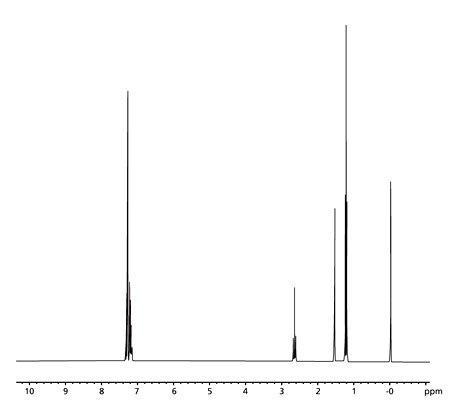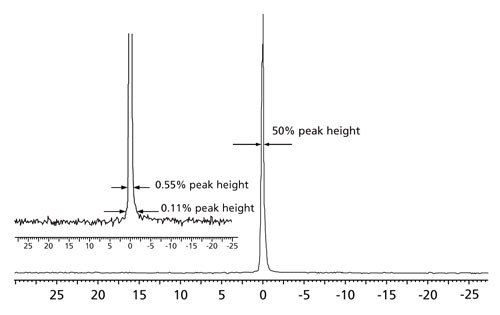NMR Reference Standards
Suitable for instrument qualification and performance verification of modern NMR instruments
Over the last decade, the utility of Nuclear Magnetic Resonance (NMR) spectroscopy has expanded. Traditionally, NMR spectroscopy was primarily a qualitative method used for structural identification. With the introduction of high field NMR instruments (600 MHz and higher), NMR is increasingly used in quantitative applications with sensitivities into the parts per billion range. These applications include binding studies for drug screening, metabolite identification, cGMP release testing and trace level analysis of impurities, such as residual solvents. At the same time, analytical laboratories have been required to demonstrate tighter instrument controls as customer expectations related to quality systems have increased. ISO-9001 standards and cGMP equipment validation require the spectroscopist to demonstrate consistent and reliable instrument performance. This has resulted in a need to use NMR reference standards to ensure proper instrument performance in quantitative applications.
Quality assurance of NMR instrument performance typically includes methods for Installation Qualification (IQ) and Operational Qualification (OQ), which we have supported through the sale of its NMR reagents and standards. However, Performance Qualification (PQ), which allows the user to routinely verify their instrument performance, is essential for meaningful quantitative results. All three methods ensure instrument performance at every stage, from initial installation and operational functionality in the selected environment to reliable performance during routine use. We are a well-established supplier of standards and reagents to the NMR community. We also offer a wide range of NMR reference standards needed to verify instrument performance. These standards allow the user to monitor key operational parameters such as pw90, sensitivity, resolution and line shape (see Table 1).
Sensitivity and pw90
The 1H sensitivity standard (0.1% ethylbenzene / 0.01% TMS / CDCl3) is widely used by the NMR community to evaluate the signal-to-noise ratio (SNR) in the 3 to 7 ppm range for a variety of NMR instruments (see Figure 1). To accurately assess the SNR and, therefore, instrument performance, spurious peaks from impurities must be avoided. Hence, the use of high purity reagents and solvents is important. This standard is also recommended to determine the 90-degree pulse width (pw90), an essential parameter for any NMR experiment. For 13C sensitivity, the preferred industry standard among spectroscopists is 40% p-dioxane/ benzene-d6. It is also used for 13C line shape verification. Keep in mind that certain aspects of system suitability such as line shape and sensitivity are also affected by precision. This is directly related to sample preparation and accuracy, which is associated with self-consistency among the integrated signals within the molecule1. Using our NMR reference standards eliminate sample preparation uncertainty when evaluating instrument performance. Our Stable Isotope Group has a long history of supplying NMR reference standards for instrument qualification. We have the high quality materials, meticulous preparation and QC procedures in place to provide the user with reliable, high quality standards.

Figure 1. Our Proton (1H) Sensitivity Standard (0.1% ethylbenzene / 0.01% TMS / CDCl3)
Line Shape
Another essential parameter for the NMR spectroscopist is magnetic field homogeneity, which is indicated by the NMR signal line shape. The 1H Line Shape Standard (1% or 5% Chloroform / Acetone-d6) is used to demonstrate that the NMR instrument meets the manufacturer’s line shape specifications. Optimized shimming of the NMR instrument is required to achieve the designated values. The line width is measured at three peak heights: 50%, 0.55%, and 0.11% (see Figure 2) and the measured peak widths are compared to the manufacturer’s specifications to either initially qualify the instrument or verify its performance. As mentioned earlier, we also provide NMR reference standards to evaluate the 13C signal line shape (40% p-Dioxane / Benzene-d6). It is used in a manner similar to the proton line shape standard to verify instrument performance. In routine use, when a line shape does not meet the user’s expectations, this may be due to field inhomogeneity or a resonance from a possible impurity overlapping with the analyte. Verifying the performance with a reusable NMR reference standard removes these variables and allows the spectroscopist to compare the results with historical instrument performance.

Figure 2. Proton (1H) Line Shape Standard (1% Chloroform / Acetone-d6)
Resolution
Resolution directly affects the peak separation and hence is associated with sensitivity and line broadening issues. For 1H NMR, resolution is checked using 1% 1,2-Dichlorobenzene / Acetone-d6. Peak sharpness and resolution are important for low-level analyses especially when a mixture is being tested.
We are committed to providing the highest quality NMR standards and reagents, and maintaining its leadership position as a trusted name in the NMR community. We have the combined knowledge and expertise to supply the standards required to ensure proper instrumental qualification and performance verification. Looking for ward, we have the passion and resources to continually expand our product offering. Although quantitative NMR is usually associated with 1H NMR, applications continue to grow in 19F NMR and 31P NMR. Our Stable Isotope Group also provides NMR reference standards for Fluorine Sensitivity and Phosphorus Sensitivity verification and other applications. The NMR Reference Standards are also available in several tube sizes from 3 mm x 8” to 10mm x 8”. NMR continues to find new and exciting applications to solve today’s analytical challenges. Count on us to provide the relevant and high-quality reagents necessary to ensure reliable NMR analyses. Besides reference standards, we offer many other product lines for NMR, including:
- Deuterated NMR solvents (Chloroform-d, Methanol-d4,Deuteriumoxide, Dimethyl sulfoxide-d6)
- Labeled products for synthesis
- Derivatization reagents
- NMR tubes, cleaners and accessories (Wilmad, Norell, Shigemi brands)
- 13C and 1H FT-NMR Libraries with Spectral Viewer in Text and CD-ROM versions
- Reference books and software
Please visit our NMR Reference Standard webpage for a full list of products.
Materials
References
To continue reading please sign in or create an account.
Don't Have An Account?